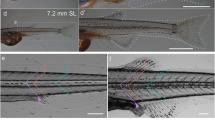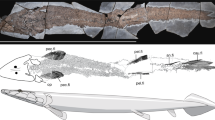Abstract
Recent fossil finds and experimental analysis of chick and mouse embryos highlighted the lateral fin fold theory, which suggests that two pairs of limbs in tetrapods evolved by subdivision of an elongated single fin1. Here we examine fin development in embryos of the primitive cartilaginous fish, Scyliorhinus canicula (dogfish) using scanning electron microscopy and investigate expression of genes known to be involved in limb positioning, identity and patterning in higher vertebrates. Although we did not detect lateral fin folds in dogfish embryos, Engrailed-1 expression suggests that the body is compartmentalized dorso-ventrally. Furthermore, specification of limb identity occurs through the Tbx4 and Tbx5 genes, as in higher vertebrates. In contrast, unlike higher vertebrates, we did not detect Shh transcripts in dogfish fin-buds, although dHand (a gene involved in establishing Shh) is expressed. In S. canicula, the main fin axis seems to lie parallel to the body axis. ‘Freeing’ fins from the body axis and establishing a separate ‘limb’ axis has been proposed to be a crucial step in evolution of tetrapod limbs2,3. We suggest that Shh plays a critical role in this process.
This is a preview of subscription content, access via your institution
Access options
Subscribe to this journal
Receive 51 print issues and online access
$199.00 per year
only $3.90 per issue
Buy this article
- Purchase on Springer Link
- Instant access to full article PDF
Prices may be subject to local taxes which are calculated during checkout




Similar content being viewed by others
References
Thacher, J. K. Median and paired fins, a contribution to the history of vertebrate limbs. Trans. Conn. Acad. 3, 281–310 (1877).
Jarvik, E. in Basic Structure and Evolution of Vertebrates 109–131 (Academic, London, 1980).
Moy-Thomas, J. A. The evolution of the pectoral fins of fishes and the tetrapod forelimb. School Sci. Rev. 36, 592–599 (1936).
Coates, M. I. The origin of vertebrate limbs. Development (1994 Suppl.), 169–180 (1994).
Shu, D.-G. et al. Lower Cambrian vertebrates from South China. Nature 402, 42–46 (1999).
Neyt, C. et al. Evolutionary origins of vertebrate appendicular muscle. Nature 408, 82–86 (2000).
Balfour, F. M. The development of elasmobranch fishes. J. Anat. Physiol. Lond. 11, 128–172 (1876).
Ballard, W. W., Mellinger, J. & Lechenault, H. A series of normal stages for development of Scyliorhinus canicula, the lesser spotted dogfish (Chondrichthyes: Scyliohinidae). J. Exp. Zool. 267, 318–336 (1993).
Altabef, M., Clarke, J. D. & Tickle, C. Dorso-ventral ectodermal compartments and origin of apical ectodermal ridge in developing chick limb. Development 124, 4547–4556 (1997).
Tanaka, M. et al. Apical ectodermal ridge induction by the transplantation of En-1-overexpressing ectoderm in chick limb bud. Dev. Growth Differ. 40, 423–429 (1998).
Tabin, C. & Laufer, E. Hox genes and serial homology. Nature 361, 692–693 (1993).
Coates, M. I. Hox genes, fin folds and symmetry. Nature 364, 195–196 (1993).
Tamura, K. et al. Evolutionary aspects of positioning and identification of vertebrate limbs. J. Anat. 199, 195–204 (2001).
Ruvinsky, I., Silver, L. M. & Gibson-Brown, J. J. Phylogenetic analysis of T-box genes demonstrates the importance of amphioxus for understanding evolution of the vertebrate genome. Genetics 156, 1249–1257 (2000).
Balinsky, B. I. Das extremitaetenseitenfeld, seine ausdehnung und beschaffenheit. Roux Arch. Dev. Biol 130, 704–736 (1933).
Cohn, M. J., Izpisua-Belmonte, J. C., Abud, H., Heath, J. K. & Tickle, C. Fibroblast growth factors induce additional limb development from the flank of chick embryo. Cell 80, 739–746 (1995).
Tanaka, M. et al. Distribution of polarizing activity and potential for limb formation in mouse and chick embryos and possible relationship to polydactyly. Development 127, 4011–4021 (2000).
Riddle, R. D., Johnson, R. L., Laufer, E. & Tabin, C. Sonic hedgehog mediates the polarizing activity of the ZPA. Cell 75, 1401–1416 (1993).
Ekker, S. C. et al. Patterning activities of vertebrate hedgehog proteins in the developing eye and brain. Curr. Biol. 5, 44–55 (1995).
Cohn, M. J. Giving limbs a hand. Nature 406, 953–954 (2000).
Tümpel, S. et al. Antero-posterior signaling in vertebrate limb development and stripes of Tbx3 expression. Dev. Biol (submitted).
Kraus, P., Fraidenraich, D. & Loomis, C. A. Some distal limb structures develop in mice lacking Sonic hedgehog signaling. Mech. Dev. 100, 45–58 (2001).
Mazan, S., Jaillard, D., Baratte, B. & Janvier, P. Otx1 gene-controlled morphogenesis of the horizontal semicircular canal and the origin of the gnathostome characteristics. Evol. Dev. 2, 186–193 (2000).
Wilkinson, D. G. In Situ Hybridization: A Practical Approach 75–83 (IRL Press/Oxford Univ. Press, Oxford, 1992).
Kuratani, S., Ueki, T., Aizawa, S. & Hirano, S. Peripheral development of cranial nerves in a cyclostome, Lampetra japonica: morphological distribution of nerve branches and the vertebrate body plan. J. Comp. Neurol. 384, 482–500 (1997).
Schlosser, G. & Roth, G. Evolution of nerve development in frogs. I. The development of the peripheral nervous system in Discoglossus pictus (Discoglossidae). Brain Behav. Evol. 50, 61–93 (1997).
Münsterberg, A. E., Kitajewski, J., Bumcrot, D. A., McMahon, A. P. & Lassar, A. B. Combinatorial signaling by Sonic hedgehog and Wnt family members induces myogenic bHLH gene expression in the somite. Genes Dev. 9, 2911–2922 (1995).
Coates, M. I. Limb evolution. Fish fins or tetrapod limbs—a simple twist of fate? Curr. Biol. 5, 844–848 (1995).
Acknowledgements
We are grateful to A. Wells for his assistance in maintenance of S. canicula embryos, S. Kuratani for information about S. canicula developmental studies before publication, S. Mazan for technical advice and ScOtx1and ScOtx2 cDNA as positive control probes for establishing in situ hybridization methods and N. Helps for DNA sequencing. M.T. is supported by JSPS Postdoctoral Fellowships for Research Abroad, JSPS Research Fellowships for Young Scientists and the Inoue Research Award for Young Scientists. A.M. is supported by a Wellcome Trust research Career Development Award. C.T. is Foulerton Research Professor of The Royal Society.
Author information
Authors and Affiliations
Corresponding author
Supplementary information
Rights and permissions
About this article
Cite this article
Tanaka, M., Münsterberg, A., Anderson, W. et al. Fin development in a cartilaginous fish and the origin of vertebrate limbs. Nature 416, 527–531 (2002). https://doi.org/10.1038/416527a
Received:
Accepted:
Issue Date:
DOI: https://doi.org/10.1038/416527a
This article is cited by
-
Muscle development in the shark Scyliorhinus canicula: implications for the evolution of the gnathostome head and paired appendage musculature
Frontiers in Zoology (2017)
-
Similarity of morphological composition and developmental patterning in paired fins of the elephant shark
Scientific Reports (2017)
-
The fin-to-limb transition as the re-organization of a Turing pattern
Nature Communications (2016)
-
Genoarchitecture of the rostral hindbrain of a shark: basis for understanding the emergence of the cerebellum at the agnathan–gnathostome transition
Brain Structure and Function (2016)
-
Head, Body and Fins: Patterns of Morphological Integration and Modularity in Fishes
Evolutionary Biology (2015)
Comments
By submitting a comment you agree to abide by our Terms and Community Guidelines. If you find something abusive or that does not comply with our terms or guidelines please flag it as inappropriate.



